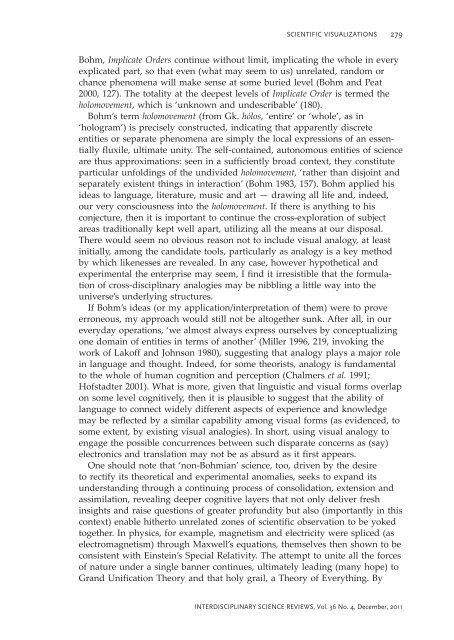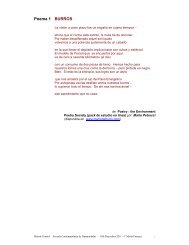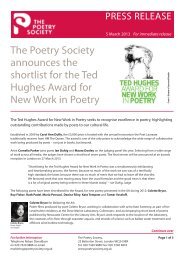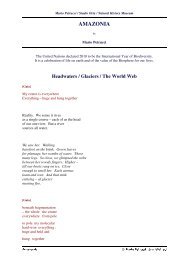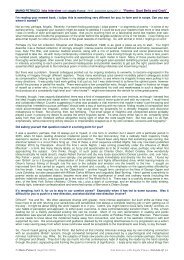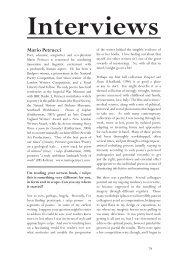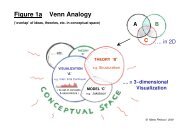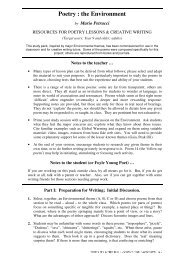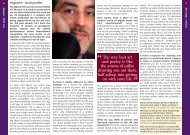Scientific Visualizations: Bridge-Building between ... - Mario Petrucci
Scientific Visualizations: Bridge-Building between ... - Mario Petrucci
Scientific Visualizations: Bridge-Building between ... - Mario Petrucci
Create successful ePaper yourself
Turn your PDF publications into a flip-book with our unique Google optimized e-Paper software.
SCIENTIFIC VISUALIZATIONS<br />
279<br />
Bohm, Implicate Orders continue without limit, implicating the whole in every<br />
explicated part, so that even (what may seem to us) unrelated, random or<br />
chance phenomena will make sense at some buried level (Bohm and Peat<br />
2000, 127). The totality at the deepest levels of Implicate Order is termed the<br />
holomovement, which is ‘unknown and undescribable’ (180).<br />
Bohm’s term holomovement (from Gk. hólos, ‘entire’ or ‘whole’, as in<br />
‘hologram’) is precisely constructed, indicating that apparently discrete<br />
entities or separate phenomena are simply the local expressions of an essentially<br />
fluxile, ultimate unity. The self-contained, autonomous entities of science<br />
are thus approximations: seen in a sufficiently broad context, they constitute<br />
particular unfoldings of the undivided holomovement, ‘rather than disjoint and<br />
separately existent things in interaction’ (Bohm 1983, 157). Bohm applied his<br />
ideas to language, literature, music and art — drawing all life and, indeed,<br />
our very consciousness into the holomovement. If there is anything to his<br />
conjecture, then it is important to continue the cross-exploration of subject<br />
areas traditionally kept well apart, utilizing all the means at our disposal.<br />
There would seem no obvious reason not to include visual analogy, at least<br />
initially, among the candidate tools, particularly as analogy is a key method<br />
by which likenesses are revealed. In any case, however hypothetical and<br />
experimental the enterprise may seem, I find it irresistible that the formulation<br />
of cross-disciplinary analogies may be nibbling a little way into the<br />
universe’s underlying structures.<br />
If Bohm’s ideas (or my application/interpretation of them) were to prove<br />
erroneous, my approach would still not be altogether sunk. After all, in our<br />
everyday operations, ‘we almost always express ourselves by conceptualizing<br />
one domain of entities in terms of another’ (Miller 1996, 219, invoking the<br />
work of Lakoff and Johnson 1980), suggesting that analogy plays a major role<br />
in language and thought. Indeed, for some theorists, analogy is fundamental<br />
to the whole of human cognition and perception (Chalmers et al. 1991;<br />
Hofstadter 2001). What is more, given that linguistic and visual forms overlap<br />
on some level cognitively, then it is plausible to suggest that the ability of<br />
language to connect widely different aspects of experience and knowledge<br />
may be reflected by a similar capability among visual forms (as evidenced, to<br />
some extent, by existing visual analogies). In short, using visual analogy to<br />
engage the possible concurrences <strong>between</strong> such disparate concerns as (say)<br />
electronics and translation may not be as absurd as it first appears.<br />
One should note that ‘non-Bohmian’ science, too, driven by the desire<br />
to rectify its theoretical and experimental anomalies, seeks to expand its<br />
understanding through a continuing process of consolidation, extension and<br />
assimilation, revealing deeper cognitive layers that not only deliver fresh<br />
insights and raise questions of greater profundity but also (importantly in this<br />
context) enable hitherto unrelated zones of scientific observation to be yoked<br />
together. In physics, for example, magnetism and electricity were spliced (as<br />
electromagnetism) through Maxwell’s equations, themselves then shown to be<br />
consistent with Einstein’s Special Relativity. The attempt to unite all the forces<br />
of nature under a single banner continues, ultimately leading (many hope) to<br />
Grand Unification Theory and that holy grail, a Theory of Everything. By<br />
INTERDISCIPLINARY SCIENCE REVIEWS, Vol. 36 No. 4, December, 2011


